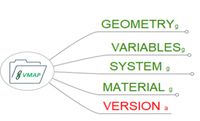Storage Structure
The VMAP Standard specifications form the core of the standard. Since, VMAP is driven by industry and software vendors, the main focus of VMAP has been to align the CAE data in a form which is generic and at the same time encompasses all aspects of it. During the project, we have aligned the data into groups and found commonalities among many softwares to build the standard.
Keeping this in mind, the VMAP storage structure defines the four main groups which form the essence of any simulation – GEOMETRY, VARIABLES, SYSTEM and MATERIAL. Within these four main groups, the CAE data is sorted into datasets and attributes. While points, elements, parts, specific variable name (both input & output) are some of the datasets, the details and metadata for all these datasets is provided by the attributes. Although, it is worthy to note that the Standard is an outcome of the VMAP Project and the partners within the project defined ideas to keep the standard generic and cover the CAE domain, the commonly used and known numerical definitions, like element definitions, interpolation rules, integrations rules etc., have been taken as it is. The VMAP Standard offers twenty-five different element types including points and user-defined elements. It also offers a dictionary of more than ninety integration types like, Simpson, Gauss, Trapezoidal, Lobatto and user-defined types. In addition, combined integration types can be created and composite integration types based on the number of layers and thickness of the composites. It defines some of the most common results/material properties which were identified in early stages of the project. This list is ever-growing with more than fifty variables available already. Dimensions like scalar, vector, second order plain tensor, second order tensor asymmetric/symmetric, stiffness matrix, fourth order tensor asymmetric / symmetric and interpolation types like linear, bilinear, cubic, spline etc. are supported as well. The basic coordinate systems like Cartesian and non-orthogonal are already indexed in the standard and can be used directly. VMAP Standard uses the SI unit system to define the measurements, however, it offers the opportunity to use scale and shift factors to use any other units for measurements.
In addition to the four main groups, VMAP supports storage of tables, which can come in handy while storing material model data.
Since, most simulation results are domain specific, e.g. structural, thermal, acoustics etc., there is a possibility to identify this using the element type attribute. This feature is directly influenced from most of the widely used simulation solvers. The figure shows these four main groups along with VERSION, which is an attribute of the VMAP Standard. The following sub-sections explain the four main groups in detail.
